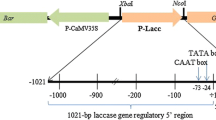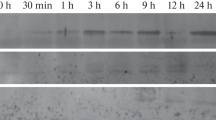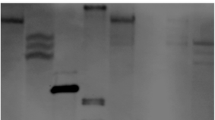Abstract
Tissue-specific patterns and levels of protein expression were characterized in transgenic carrot plants transformed with the β-glucuronidase (GUS) gene driven by one of five promoters: Cauliflower mosaic virus 35S (35S) and double 35S (D35S), Arabidopsis ubiquitin (UBQ3), mannopine synthase (mas2) from Agrobacterium tumefaciens or the rooting loci promoter (rolD) from A. rhizogenes. Five independently transformed carrot lines of each promoter construct were assessed for GUS activity. In leaves, activity was highest in plants with the D35S, 35S and UBQ3 promoters, while staining was weak in plants with the mas2 promoter, and only slight visual staining was present in the leaf veins of plants containing rolD promoter . Strong staining was seen in the lateral roots, including root tips, hairs and the vascular tissues of plants expressing the 35S, D35S and UBQ3. Lateral roots of plants containing the rolD construct also showed staining in these tissues while the mas2 promoter exhibited heightened staining in the root tips. Relatively strong GUS staining was seen throughout the tap root with all the promoters tested.. When GUS expression was quantified, the UBQ3 promoter provided the highest activity in roots of mature plants, while plants with the D35S and 35S promoter constructs had higher activity in the leaves. Although plants containing the mas2 promoter had higher levels of activity compared to the rolD plants, these two promoters were significantly weaker than D35S, 35S and UBQ3. The potential for utilization of specific promoters to target expression of desired transgenes in carrot tissues is demonstrated.




Similar content being viewed by others
References
Ammirato PV (1986) Carrot. In: Evans DA, Sharp WR, Ammirato PV (eds) Handbook of plant cell culture, vol 4. Macmillan, New York, pp 457–499
Bouche FB, Marquet-Blouin E, Yanagi Y, Steinmetz A, Muller CP (2003) Neutralising immunogenity of a polypitote antigen expressed in transgenic food plant: a novel antigen to protect against measles. Vaccine 21:2065–2072
Chen WP, Punja ZK (2002) Transgenic herbicide- and disease-tolerant carrot (Daucus carota L.) plants obtained through Agrobacterium-mediated transformation. Plant Cell Rep 20:929–935
Christensen AH, Sharrock RA, Quail PH (1992) Maize polyubiquitin genes: structure, thermal perturbation of expression and transcript splicing, and promoter activity following transfer to protoplasts by electroporation. Plant Mol Biol 18:675–689
Comai L, Moran P, Maslyar D (1990) Novel and useful properties of a chimeric plant promoter combining CaMV 35S and MAS elements. Plant Mol Biol 15:373–381
Elmayan T, Tepfer M (1995) Evaluation in tobacco of the organ specificity and strength of the rolD promoter, domain A of the 3 s promoter and the 35S2 promoter. Transgenic Res 4:388–396
Fei H, Chaillou S, Hirel B, Mahon JD, Vessey JK (2003) Overexpresssion of a soybean cytosolic glutamine synthase gene linked to organ-specific promoters in pea plants grown in different concentrations of nitrate. Planta 216:467–474
Feltkamp D, Baumann E, Schmalenbach W, Masterson R, Rosahal S (1995) Expression of the mannopine synthase promoter in roots is dependent on the mas elements and correlates with high transcript levels of mas-binding factor. Plant Sci 109:57–65
Fraisier V, Gojon A, Tillard P, Daniel-Vedele F (2000) Constitutive expression of a putative high-affinity nitrate transporter in Nicotiana plumbaginifolia: evidence for post-transcriptional regulation by a reduced nitrogen source. Plant J 23:489–496
Gandhi R, Maheshwari SC, Khurana P (1999) Transient gene expression and influence on foreign gene expression in Arabidopsis thaliana. In Vitro Cell Dev Biol Plant 35:232–237
Gilbert MO, Zhang YY, Punja ZK (1996) Introduction and expression of chitinase encoding genes in carrot following Agrobacterium-mediated transformation. In Vitro Cell Dev Biol Plant 32:171–178
Guevara-Garcia A, Lopez-Bucio J, Herrera-Estrella L (1999) The mannopine synthase promoter contains vectorial cis-regulatory elements that act as enhancers and silencers. Mol Gen Genet 262:608–617
Holtorf S, Apel K, Bohlmann H (1995) Comparison of different constitutive and inducible promoters for the overexpression of transgenes in Arabidopsis thaliana. Plant Mol Biol 29:637–646
Jayaraj J, Punja ZK (2007) Combined expression of chitinases and lipid transfer protein genes in transgenic carrot plants enhances resistance to foliar fungal pathogens. Plant Cell Rep 26:1539–1546
Jayaraj J, Devlin R, Punja Z (2007) Metabolic engineering of novel ketocarotenoid production in carrot plants. Transgenic Res. doi:10.1007/s11248-007-9120-0
Jefferson RA, Kavanagh RA, Bevan MW (1987) GUS-fusions: β-glucuronidase as a sensitive and versatile fusion marker in higher plants. EMBO J 6:3901–3907
Kamo KK (2003) Long-term expression of the uidA gene in Gladiolus plants under control of either the ubiquitin, rolD, mannopine synthase, or cauliflower mosaic virus promoters following three seasons of dormancy. Plant Cell Rep 21:797–803
Kamo K, Blowers A (1999) Tissue specificity and expression level of GUSA under rolD, mannopine synthase and translation elongation factor 1 subunit alpha promoters in transgenic Gladiolus plants. Plant Cell Rep 18:809–815
Kay R, Chan A, Daly M, McPerson J (1987) Duplication of a CaMV 35S promoter sequences creates a strong enhancer for plant genes. Science 236:1299–1302
Komamine A, Murata N, Nomura K (2005) Mechanisms of somatic embryogenesis in carrot suspension cultures—morphology, physiology, biochemistry, and molecular biology. In Vitro Cell Dev Biol Plant 41:6–10
Kumar S, Dhingra A, Daniell H (2004) Plastid-expressed betaine aldehyde dehydrogenase gene in carrot cultured cells, roots, and leaves confers enhanced salt tolerance. Plant Physiol 136:2843–2854
Langridge WHR, Fitzgerald KJ, Koncz C, Schell J, Szalay AA (1989) Dual promoter of Agrobacterium tumefaciens mannopine synthase genes is regulated by plant growth hormones. Proc Natl Acad Sci USA 86:3219–3223
Leach F, Aoyagi K (1991) Promoter analysis of the highly expressed rolC and rolD root-inducing genes of Agrobacterium-rhizogenes-enhancer and tissue-specific DNA determinants are dissociated. Plant Sci 79:69–76
Malik K, Wu K, Li XQ, Martin-Heller T, Hu M, Foster E, Tian L, Wang C, Ward K, Jordan M, Brown D, Gleddie S, Simmonds D, Zheng S, Simmonds J, Miki B (2002) A constitutive gene expression system derived from the tCUP cryptic promoter elements. Theor Appl Genet 105:505–514
Marquet-Blouin E, Bouche FB, Steinmetz A, Muller CP (2003) Neutralizing immunogenicity of transgenic carrot (Daucus carota L.)-derived measles virus hemagglutin. Plant Mol Biol 51:459–469
Melchers LS, Stuiver MH (2000) Novel genes for disease-resistance breeding. Curr Opin Plant Biol 3:147–152
Murashige T, Skoog F (1962) A revised medium for rapid growth and bioassays with tobacco tissue cultures. Physiol Plant 15:473–492
Ni M, Cui D, Einstein J, Narasimhulu S, Vergara CE, Gelvin SB (1995) Strength and time specificity of chimeric promoters derived from the octopine and mannopine synthase genes. Plant J 7:661–676
Norris SR, Meyer SE, Callis J (1993) The intron of Arabidopsis thaliana polyubiquitin genes is conserved in location and is a quantitative determinant of chimeric gene expression. Plant Mol Biol 21:895–906
Odell JT, Nagy F, Chua NH (1985) Identification of DNA sequences required for activity of the cauliflower mosaic virus 35S promoter. Nature 313:810–812
Pauk J, Stefanov I, Fekete S, Borge L, Karsai I, Feher A, Dudits D (1995) A study of different (CaMV 35S and mas) promoter activities and risk assessment of field use in transgenic rapeseed plants. Euphytica 85:411–416
Potenza C, Aleman L, Sengupta-Copalan C (2004) Targeting transgene expression in research, agricultural, and environmental applications: promoters used in plant transformation. In Vitro Cell Dev Biol Plant 40:1–22
Samac DA, Tesfaye M, Dornbusch M, Saruul P, Temple SJ (2004) A comparison of constitutive promoters for expression of transgenes in alfalfa (Medicago sativa). Transgenic Res 13:349–361
Sambrook J, Fritsch EF, Maniatis T (1989) Molecular cloning: A laboratory manual, 2nd edn. Cold Spring Harbor Laboratory Press, Cold Spring Harbor
Schledzewski K, Mendel RR (1994) Quantitative transient gene expression: comparison of the promoters for maize polyubiquitin1, rice actin1, maize-derived Emu and CaMV 35S in cells of barley, maize and tobacco. Transgenic Res 3:249–255
Takaichi M, Oeda K (2000) Transgenic carrots with enhanced resistance against two major pathogens, Erysiphe heraclei and Alternaria dauci. Plant Sci 153:135–144
Wally O, Jayaraman J, Punja ZK (2006) Carrot (Daucus carota L.) transformation. In: Wang K (eds) Methods in molecular biology. Agrobacterium protocols, vol. 44. Humana Press Inc, NJ, pp 3–15
Zimmerman JL (1993) Somatic embryogenesis: a model for early developments in higher plants. Plant Cell 5:1411–1423
Acknowledgments
Funding for this research was provided by NSERC (Natural Sciences and Engineering Research Council of Canada), Discovery Grants program. We would like to thank Dr. Jin-Gui Chen and Dr. Shucai Wang (University of British Columbia, Canada) for use of their 96-well fluorometer, Dr. Jim Mattsson (Simon Fraser University) for use of a digital imaging microscope, and Lisa Leippi for assistance in preparation of graphs and photos.
Author information
Authors and Affiliations
Corresponding author
Additional information
Communicated by W. Harwood.
Rights and permissions
About this article
Cite this article
Wally, O., Jayaraj, J. & Punja, Z.K. Comparative expression of β-glucuronidase with five different promoters in transgenic carrot (Daucus carota L.) root and leaf tissues. Plant Cell Rep 27, 279–287 (2008). https://doi.org/10.1007/s00299-007-0461-1
Received:
Revised:
Accepted:
Published:
Issue Date:
DOI: https://doi.org/10.1007/s00299-007-0461-1




